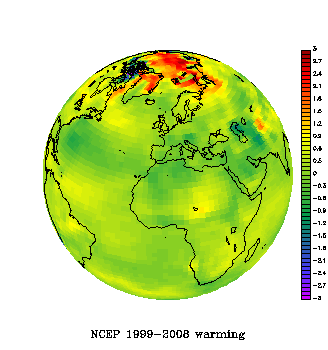No, not the stuff in the stolen emails — although the University of East Anglia and its Climatic Research Unit (CRU) have yet another statement out I’ll excerpt below. It notes “Over 95% of the CRU climate data set concerning land surface temperatures has been accessible to climate researchers, sceptics and the public for several years.”
No, the vital climate data that the Hadley Center and CRU are withholding from the public is the warming taking place in the Arctic (see “What exactly is polar amplification and why does it matter?“). And that missing data is why NASA’s Goddard Institute for Space Studies data are almost certainly superior to CRU’s data “developed in conjunction with Hadley Centre of the UK Met Office.”
Remember, “there are no permanent weather stations in the Arctic Ocean, the place on Earth that has been warming fastest,” as New Scientist explained (see here and here). “The UK’s Hadley Centre record simply excludes this area, whereas the NASA version assumes its surface temperature is the same as that of the nearest land-based stations.” Thus it is almost certainly the case that the planet has warmed up more this decade than NASA says, and especially more than the UK’s Hadley Center says.
 RealClimate has an excellent post on this very subject — “the ‘hole in the Arctic’ in the Hadley data, just where recent warming has been greatest” — with this great figure (and caption):
RealClimate has an excellent post on this very subject — “the ‘hole in the Arctic’ in the Hadley data, just where recent warming has been greatest” — with this great figure (and caption):
Figure. The animated graph shows the temperature difference between the two 5-year periods 1999-2003 and 2004-2008. The largest warming has occurred over the Arctic in the past decade and is missing in the Hadley data.
See also “Human-caused Arctic warming overtakes 2,000 years of natural cooling, “seminal” study finds.”
Thus contrary to what the global warming disinformers say about the recent temperature record, it is almost certainly the case that the planet has warmed up more this decade than NASA says, and especially more than the UK’s Hadley Center says.
So that’s why the NASA temperature record should be seen as more accurate, which puts 2005 as the warmest year on record, with 2007 just edging out 1998 for second warmest. This is “the hottest decade the planet has experienced in many thousands of years,” as climatologist Ken Caldeira puts it. NASA has reported June to October were the hottest on record.* And next year may well be the warmest on record.
So, no, there hasn’t been any recent “global cooling” even for the surface temperature record. And when you look at where 90% of the human-caused warming was expected to go — the oceans — you find steady warming over the past several years:
And yes, I’m going to use that graph until the status quo media starts getting this warming story right (see “Skeptical Science explains how we know global warming is happening: It’s the oceans, stupid!“). And I’ll repeat that a new NOAA-led study, “An observationally based energy balance for the Earth since 1950” (subs. req’d, release here) concluded:
[S]ince 1950, the planet released about 20 percent of the warming influence of heat-trapping greenhouse gases to outer space as infrared energy. Volcanic emissions lingering in the stratosphere offset about 20 percent of the heating by bouncing solar radiation back to space before it reached the surface. Cooling from the lower-atmosphere aerosols produced by humans balanced 50 percent of the heating. Only the remaining 10 percent of greenhouse-gas warming actually went into heating the Earth, and almost all of it went into the ocean.
So the Hadley-CRU data is missing the place on the surface where the most warming has occurred — and like all surface temperature data, it doesn’t track the part of the planet where most of the warming goes.
As for CRU’s actual data, here is what they have to say in their November 28 news release on the subject:
CRU climate data already ‘over 95%’ available
Over 95% of the CRU climate data set concerning land surface temperatures has been accessible to climate researchers, sceptics and the public for several years the University of East Anglia has confirmed.
“It is well known within the scientific community and particularly those who are sceptical of climate change that over 95% of the raw station data has been accessible through the Global Historical Climatology Network for several years. We are quite clearly not hiding information which seems to be the speculation on some blogs and by some media commentators,” commented the University’s Pro-Vice-Chancellor, Research Enterprise and Engagement Professor Trevor Davies.
The University will make all the data accessible as soon a
s they are released from a range of non-publication agreements. Publication will be carried out in collaboration with the Met Office Hadley Centre.The procedure for releasing these data, which are mainly owned by National Meteorological Services (NMSs) around the globe, is by direct contact between the permanent representatives of NMSs (in the UK the Met Office).
“We are grateful for the necessary support of the Met Office in requesting the permissions for releasing the information but understand that responses may take several months and that some countries may refuse permission due to the economic value of the data,” continued Professor Davies.
The remaining data, to be published when permissions are given, generally cover areas of the world where there are fewer data collection stations.
“CRU’s full data will be published in the interests of research transparency when we have the necessary agreements. It is worth reiterating that our conclusions correlate well to those of other scientists based on the separate data sets held by the National Oceanic and Atmospheric Administration (NOAA) and the NASA Goddard Institute for Space Studies (GISS),” concluded Professor Davies.
You can, of course, find all the data you could possibly want here. It’s certainly worth reanalyzing over and over and over again because Lord knows scientists don’t know how to do that sort of thing.
You can read previously released statements from CRU, Prof Trevor Davies, Pro-Vice-Chancellor for Research, and Prof Phil Jones, head of the Climatic Research Unit, there, too.
I must say that Jones seems to be following the Tiger Woods approach to dealing with the media, and I think it is a mistake. No doubt that is what the lawyers have told them to do, but, I agree with George Marshall’s analysis in the UK’s Guardian that “There was no evidence of conspiracy among climate scientists in the leaked emails – so why was the University of East Anglia’s response so pathetic?” and that “Jones should speak to every journalist who calls, go on the offensive and defend his science” (see Reuters: “ANALYSIS-Hacked climate e-mails awkward, not game changer”).
Related Posts:
- UK Guardian: “To stop a climate catastrophe … Scientists must stop sanitising their message”
- Michael Mann updates the world on the latest climate science and responds to the illegally hacked emails
- The newspaper that publishes George Will (and Sarah Palin) editorializes: “Many — including us — find global warming deniers’ claims irresponsible.”
- Science historian Weart: “We’ve never before seen a set of people accuse an entire community of scientists of deliberate deception and other professional malfeasance. Even the tobacco companies never tried to slander legitimate cancer researchers.”
- Here’s what we know so far: CRU’s emails were hacked, the 2000s will easily be the hottest decade on record, and the planet keeps warming thanks to us!
- Newtongate: The final nail in the coffin of Renaissance and Enlightenment “thinking”
- The newspaper that publishes George Will (and Sarah Palin) editorializes: “Many — including us — find global warming deniers’ claims irresponsible.”



